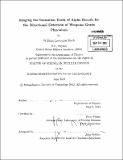| dc.contributor.advisor | Peter Fisher. | en_US |
| dc.contributor.author | Koch, William Lawrence | en_US |
| dc.contributor.other | Massachusetts Institute of Technology. Department of Physics. | en_US |
| dc.date.accessioned | 2014-01-09T19:53:52Z | |
| dc.date.available | 2014-01-09T19:53:52Z | |
| dc.date.issued | 2013 | en_US |
| dc.identifier.uri | http://hdl.handle.net/1721.1/83776 | |
| dc.description | Thesis (S.M.)--Massachusetts Institute of Technology, Dept. of Physics, 2013. | en_US |
| dc.description | Cataloged from PDF version of thesis. | en_US |
| dc.description | Includes bibliographical references (pages 71-76). | en_US |
| dc.description.abstract | Since the dawn of the nuclear weapons era, political, military, and scientific leaders around the world have been working to contain the proliferation of Special Nuclear Material and explosively fissile material. This paper describes the construction of a prototype, directional, fast neutron detector, modeled after the Dark Matter Time Projection Chamber. Fast neutrons are emitted by a host of interesting sources, including medical isotopes, research sources, cosmic neutron spallation, and the most interesting, SNM and WGP. This detector was built for remote operations using a computer terminal for the detection of Special Nuclear Material (SNM) and Weapons Grade Plutonium (WGP). Further, this paper discusses the baseline and characterization testing using a low intensity Americium-Beryllium neutron source, compared with probability-based rate calculations and Geant4 simulation rates. The detector, in its current configuration agrees well with the expected rates, showing a 95% track reconstruction efficiency, computed from both the probability-based rate calculation and the Geant4 simulation rates. Scaling this to an appropriate size, this detector provides an entirely unique and new piece of information in the world of radiation detection: direction to fast neutron source. The primary concept of employment focuses on building statistics through large total cross section, increased scan time, or proximity of scan source. With these three variables balanced for a specific operational environment, this detector technology is able to pinpoint fast neutron sources in a wide variety of scenarios. | en_US |
| dc.description.statementofresponsibility | by William Lawrence Koch. | en_US |
| dc.format.extent | 80 pages | en_US |
| dc.language.iso | eng | en_US |
| dc.publisher | Massachusetts Institute of Technology | en_US |
| dc.rights | M.I.T. theses are protected by
copyright. They may be viewed from this source for any purpose, but
reproduction or distribution in any format is prohibited without written
permission. See provided URL for inquiries about permission. | en_US |
| dc.rights.uri | http://dspace.mit.edu/handle/1721.1/7582 | en_US |
| dc.subject | Physics. | en_US |
| dc.title | Imaging the ionization track of alpha recoils for the directional detection of weapons grade plutonium | en_US |
| dc.type | Thesis | en_US |
| dc.description.degree | S.M. | en_US |
| dc.contributor.department | Massachusetts Institute of Technology. Department of Physics | |
| dc.identifier.oclc | 864897377 | en_US |
